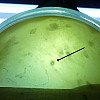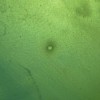Phage Isolation Journal
Introduction
I've been interested in phages since seeing the artistic renditions of the crystalline capsid containing the viral DNA, not quite alive, but able to replicate and evolve side by side with their host bacteria... much more complex and large machines.
If you haven't heard about Phage Therapy I recommend checking out the wikipedia article and this TED talk as an introduction. Healers need to realize we're in a relationship with a very complex network of life and death to operate morally, to simply state we "do no harm" while hiding behind profitable statistics does not make it true.
4/13/20
Looks like I've got some phage plaques for the first time 4/12/2020
It was really exciting to see plaques for the first time just hours after inoculating the bacterial lawn.
I just need to make some quick notes for now. I'm working on getting a bit more setup before I can really get on to the isolation, amplification, serial dilutions and all that.
I've been using the SEA-PHAGES protocol as a basis for my own work so far, but with the intention of writing a barebones and shoestring budget phage isolation guide of some sort. Now that I've actually begun work, I'm starting to see things combine and I get giddy because of the possibilities. Once I start doing serial dilutions so I can estimate the number of viral particles in a solution, and then with the Mutagenesis Chamber expose them, damaging them and generating a distribution of mutations. Then I'd have the challenge of isolating and amplifying mutant lines of phages. Also with the numbers I could alter the x-ray exposure power and time to create a model/curve showing mutations vs. those variables. I could do the same with the seeds, but the large numbers and rapidity of microbiology makes the discovery go so much faster.
I picked up an autoclave a little over a month ago because I wanted to start working on this project before sh-t started to really hit the fan because of the 2020 pandemic. I also began frantically trying to pick up a qPCR machine and the DNA templates so I could do my own covid19 testing, this didn't work out (probably for the best, "first things first" before dropping thousands on a random machine... I was thinking of it as an investment too in a sense, figuring that picking up a surplus qPCR machine from California might be of use to a local lab here, knowing how well AZ is handling things. The DNA company cancelled my order for PCR covid templates and positive control fragments. This isn't even related to phage isolation.)
Regarding phage isolation, I used the autoclave to sterilize food grade agar and nutrient made from a mixture of beef broth, sugar, salt and RO water strained through a paper towel and mixed with molten agar strips all from the asian international market. I've had a bit of a difficult time keeping the agar molten, so I've invested in a janky hotplate stirrer (on it's way) that I plan to restore and use to keep the agar molten for pouring plates. I also plan on getting better quality ingredients to make some legit LB agar and broth.
I've been keeping a culture of a bacteria isolated from a plate doused with bactrim and smeared with a urine sample. I took a bit of isolated culture and placed it into a beef broth that has been just sitting at 77F (room temp), I tried making bacterial lawns, but the bacteria seem to clump at the bottom so the lawns were actually very sparse with only scattered isolated colonies for the most part. So I just poured broth on a couple plates and let them sit for a while. Eventually before throwing the failed lawn plates out I decided to just see what kind of results I would get without using a phage buffer, just plain RO water and an filtered environmental sample.
I collected some dirt from under the compost bin placed it in a round bottom Falcon tube and vortexed it, then placed it in the centrifuge for a minute. I took a 5ml luer lock syringe and attached a .22um syringe filter, you could use a life straw as a filter in a survival situation, you're getting a dose of enviromental bacteriophages through the straw! The syringe plunger was removed and the dirty water was poured off from the dirt and other solid debris. The plunger was re-inserted and depressed while collecting the filtrate into another falcon tube.
From here I took a sterile swab and swabbed the surface of one of the poured lawn plates with some of the filtrate, spreading evenly.
I checked back on the plate before going to bed not expecting much, but was surprised that the phages had already formed their full plaques. I counted around 10 total, with one nice large plaque morphology. This was really exciting, I have always been a fan of these little self-replicating machine crystals since forever and now I was able to see them with my own eyes in a sense.
If you look carefully on the first picture you can pick out a couple other tiny plaques
That's about all I can do for now, I just got my 1.5ml microfuge tubes in today, still waiting on the pipettes and tips. Need to make a batch of phage buffer next. I've also ordered a mini lab incubator so I can try and get my broths going properly for amplification. Still under a thousand bucks for the lab, but I think once I pick up a mini fridge I'll be pushing that line. I think I'd probably want to spend close to that much for just a microscope setup, but I'm STILL in no rush to get one, even though I've wanted a nice microscope since FOREVER, I remember just watching everything in pond scum with so much fascination, but it would be useful for determining the host bacteria for this project of course... but I would spend so many hours just looking at festering water.
That's it for tonight. Maybe this will be useful, but it's just really quick notes and thoughts to put myself at ease that the little bit that I've done so far won't be lost TOO easily if I don't wake up. Thanks for reading.

